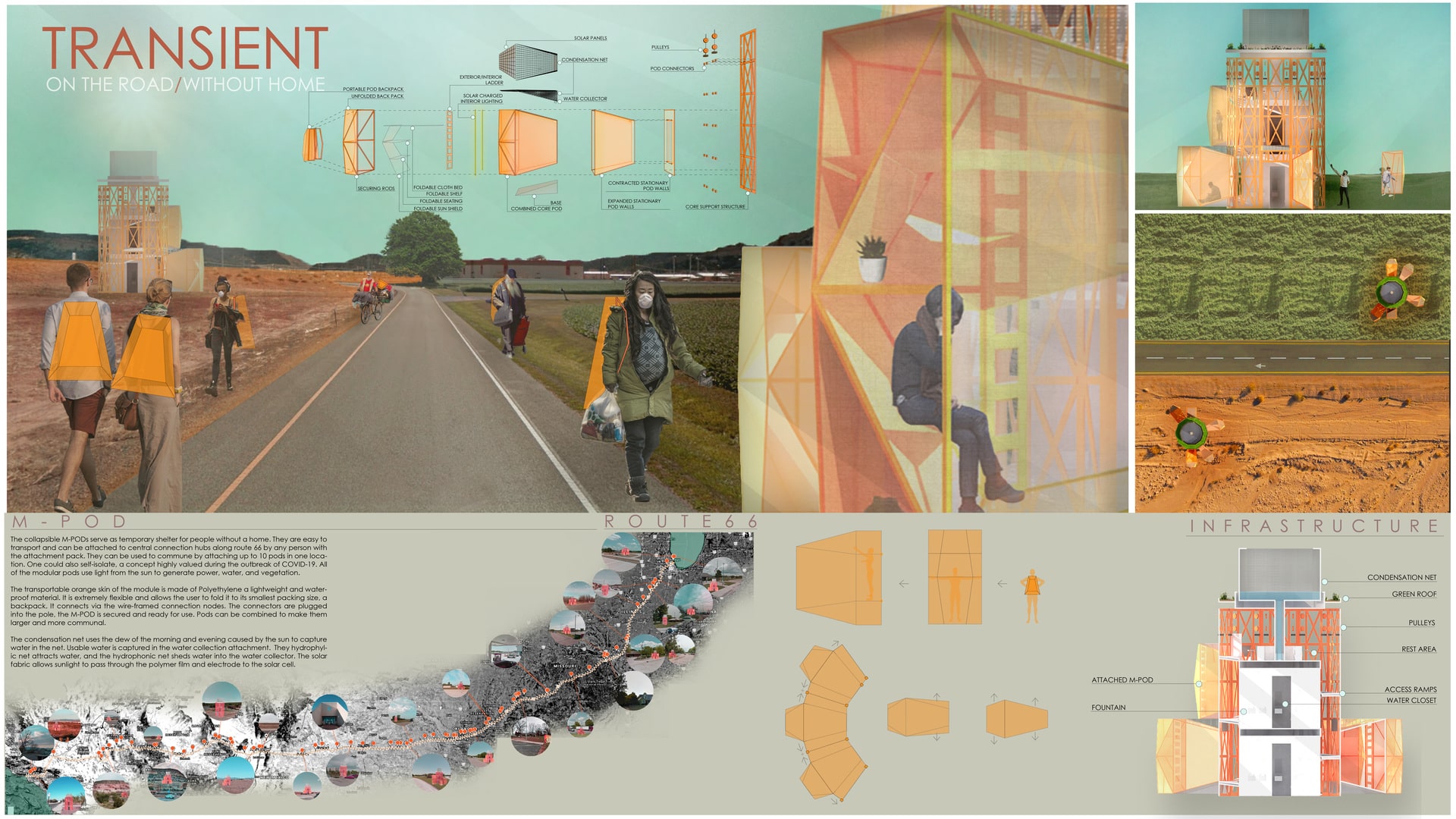Project Description
WHO + WHERE Homelessness is without a home, in a place not owned in any way. There are many terms today, urban traveler, gypsy, or transient traveler. How does the road support their way of life? While many homeless typology proposals exist, there fails to be a proposal to support their forms of travel. No matter how efficient homeless design solutions are, there will always be a form of travel for transient homeless people. Since this condition persists, This project aims to study and then aid this form of travel along route 66. This project aims to capture the unused space along route 66, to create shelters to meet the basic needs of nomadic travelers. Additionally, at night these structures will serve as shelter, road lighting, and hydration checkpoints. These structures will be placed equidistantly along the road to act as a natural guide to inform people of their location. These structures will provide a familiar or usual setting. Since they are forms of infrastructure, they are connected. Sunnier regions such as New Mexico help to feed more power back into the power grid system. Wetter regions such as Illinois will provide more vegetation and water. All pavilions will share resources so that there is mutual benefit. The excess solar power and water generated will be sent back into the power grid system, to become a source of income for security and maintenance of the infrastructure. TRANSIENT RIGHTS TO THE CITY : The Production of Space by Henri Lefebvre redefines how space is perceived space. Lefebvre a former situationist, believes that humans create the spaces in which they live. Architecture is expressive, walls and roads facilitate certain activities and inhibit others. Space is an interlinkage of "geographic form, built environments, symbolic meanings, or routines of life." Space is produced in domination or for human needs. This information informs this project because Lefebvre discusses the interlinkage of forms that produce space. M-Pods interlink to create space for homeless people. INTERVIEW: While speaking with two people Ernesto who traveled by van, and Bill, who traveled by foot and are currently without a home, they desired a place that could be a restroom, water filling station, with some form of monitoring to ensure its safety. M-POD is a sustainable, self-sufficient device that encompasses all of their needs. CORONAVIRUS UPDATE _ 2020 With the outbreak of the coronavirus in 2020, there has been great fear. The introduction of social distancing has caused people to self-quarantine inside of their homes. What about people without a home? Where can they social distance? I want to propose the M-POD device as a place to self-quarantine by choice but still, be connected during the Coronavirus outbreak. ABOUT THE M-POD: TRANSPORTABLE The aim is for the device to be easy to transport, assemble, and disassemble. The module's transportable interior is made of Solar fabric, and Polyethylene, a lightweight and waterproof material. It is incredibly flexible and allows the user to fold it to its smallest packing size, a backpack. The M-POD connects via the wire-framed connection nodes. CONDENSATION NET: The M-POD water condensation net filters water directly into the water collector. The water collector is for personal use. The infrastructure has a condensation net on top of the roof. It collects enough water to engage the water closets and fountains. The water collection amount may vary depending on the geographical location. SOLAR PANELS: The M-POD device uses carbon nanotechnology to capture energy from the sun more efficiently. Graphine solar fabric on the top of each pod. It lights the two interior solar lights and provides one outlet to power a device. The infrastructure uses graphine solar panels for power when needed. CONNECT COMMUNE: Personal connection pieces have been distributed to the transient [without home] population. These connection poles are located 1/4 mile from each other, alongside Route 66. When the M-Pod connector is plugged into the pole, then an individual rest pod is secured and ready for use. As people plugin, the community is created. Multiple M-Pods can be combined to make them more communal. REST + SLEEP The M-Pod Commune is a place of respite for transient people [away or without home]. It is a safe pubic place that is easy to use.
